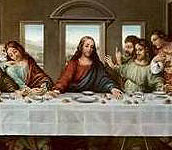
TUESDAY, March 23 (HealthDay News) — “The Last Supper” might serve as an early warning sign of bigger appetites: Over the past 1,000 years, researchers say, paintings of Christ’s final meal have shown increasingly larger portions and larger plates.
The change in artistic depiction shows that people have slowly been increasing their portion sizes over the millennium, a phenomenon that can encourage overeating, Brian Wansink, a professor of marketing and applied economics and director of the Food and Brand Lab at Cornell University, said in a university news release.
“We took the 52 most famous paintings of ‘The Last Supper’ and analyzed the size of the entrees, bread and plates, relative to the average size of the average head in the painting,” Wansink said.
The entrees on the plates and the sizes of the plates both grew by about two-thirds, according to a report on the findings in the April issue of the International Journal of Obesity. Even the bread got larger, by about 23 percent, over 1,000 years.
Wansink and his brother, a minister and professor of religious studies, used computer technology to measure the size of items in the paintings.
“The last thousand years have witnessed dramatic increases in the production, availability, safety, abundance and affordability of food,” said Wansink, author of a book titled “Mindless Eating: Why We Eat More Than We Think.”
“We think that, as art imitates life, these changes have been reflected in paintings of history’s most famous dinner,” he said.
More information
The American Diabetes Association has more on portion sizes.

